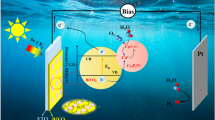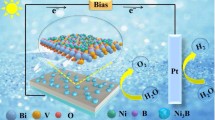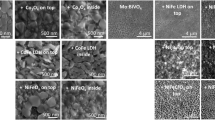Abstract
Dull surface oxygen evolution reaction (OER) dynamics seriously hinders the application of BiVO4 (BVO) photoanodes in photoelectron-chemical (PEC) water splitting. In this study, we built an inorganic/organic hybrid photo-anode to improve the PEC performance of BVO by covering a multifunctional film. The film contains modified chlorophyll (Chl) organic compounds and Co and Si ions with a gradient distribution. The Co ions present at the interface between BVO and Chl promote the transport of photogenerated holes, and the Si ions on the surface of the photoanode enhance the hydrophilicity of PEC cells. This modified Chl film not only reduces the OER barrier and promotes carrier transfer but also inhibits loss of vanadium and increases the stability of the BVO photoanode. Finally, the modified BVO photoanode exhibits a photocurrent density of 5.1 mA cm−2 at 1.23 VRHE (RHE: reversible hydrogen electrode), and the onset potential moves 350 mV negatively in 0.5 mol L−1 Na2SO4. This article provides a general and simple surface hybrid inorganic/organic solution to improve the catalytic ability of photoanodes.

摘要
钒酸铋表面缓慢的催化反应动力学严重阻碍了其在光电化学水分解领域的应用. 基于此, 我们通过覆盖多功能薄膜成功构建出无机/有机杂化光阳极以改善钒酸铋的光电化学性能. 该薄膜包含梯度分布的钴离子和硅离子以及经过改性的叶绿素有机化合物. 其中, 存在于钒酸铋和叶绿素界面处的钴离子促进了光生空穴的传输, 而光阳极表面的硅离子提升了器件的亲水性. 进一步, 该薄膜的存在有效降低了氧化反应的势垒, 促进了光生载流子转移, 同时能够抑制钒的流失并提高钒酸铋光阳极的稳定性. 总地来说, 经过修饰后的钒酸铋光阳极, 测试中光电流密度在1.23 VRHE下达到5.1 mA cm−2, 起始电位负向移动350 mV. 本文提供了一种通用且简便的无机/有机杂化电极的制备方案以提高器件的光电催化能力.
Similar content being viewed by others
References
Lee DK, Choi KS. Enhancing long-term photostability of BiVO4 photoanodes for solar water splitting by tuning electrolyte composition. Nat Energy, 2018, 3: 53–60
Fujishima A, Honda K. Electrochemical photolysis of water at a semiconductor electrode. Nature, 1972, 238: 37–38
Sun M, Gao RT, He J, et al. Photo-driven oxygen vacancies extends charge carrier lifetime for efficient solar water splitting. Angew Chem Int Ed, 2021, 60: 17601–17607
Pan Q, Li A, Zhang Y, et al. Rational design of 3D hierarchical ternary SnO2/TiO2/BiVO4 arrays photoanode toward efficient photoelec-trochemical performance. Adv Sci, 2020, 7: 1902235
Chao Y, Zhou P, Li N, et al. Ultrathin visible-light-driven Mo incorporating In2O3-ZnIn2Se4 Z-scheme nanosheet photocatalysts. Adv Mater, 2019, 31: 1807226
Landman A, Dotan H, Shter GE, et al. Photoelectrochemical water splitting in separate oxygen and hydrogen cells. Nat Mater, 2017, 16: 646–651
Kim JH, Lee JS. Elaborately modified BiVO4 photoanodes for solar water splitting. Adv Mater, 2019, 31: 1806938
Kim TW, Choi KS. Nanoporous BiVO4 photoanodes with dual-layer oxygen evolution catalysts for solar water splitting. Science, 2014, 343: 990–994
Low J, Yu J, Jaroniec M, et al. Heterojunction photocatalysts. Adv Mater, 2017, 29: 1601694
Hermans Y, Murcia-López S, Klein A, et al. BiVO4 surface reduction upon water exposure. ACS Energy Lett, 2019, 4: 2522–.l2528
Gao RT, Wang L. Stable cocatalyst-free BiVO4 photoanodes with passivated surface states for photocorrosion inhibition. Angew Chem Int Ed, 2020, 59: 23094–p23099
Jo WJ, Jang JW, Kong K, et al. Phosphate doping into monoclinic BiVO4 for enhanced photoelectrochemical water oxidation activity. Angew Chem, 2012, 124: 3201–3205
Tian Z, Zhang P, Qin P, et al. Novel black BiVO4/TiO2-x photoanode with enhanced photon absorption and charge separation for efficient and stable solar water splitting. Adv Energy Mater, 2019, 9: 1901287
Nellist MR, Qiu J, Laskowski FAL, et al. Potential-sensing electrochemical AFM shows CoPi as a hole collector and oxygen evolution catalyst on BiVO4 water-splitting photoanodes. ACS Energy Lett, 2018, 3: 2286–2291
Li H, Yu H, Quan X, et al. Improved photocatalytic performance of heterojunction by controlling the contact facet: High electron transfer capacity between TiO2 and the {110} facet of BiVO4 caused by suitable energy band alignment. Adv Funct Mater, 2015, 25: 3074–3080
Meng L, Tian W, Wu F, et al. TiO2 ALD decorated CuO/BiVO4 p-n heterojunction for improved photoelectrochemical water splitting. J Mater Sci Tech, 2019, 35: 1740–1746
Meng L, Wang S, Cao F, et al. Doping-induced amorphization, vacancy, and gradient energy band in SnS2 nanosheet arrays for improved photoelectrochemical water splitting. Angew Chem, 2019, 131: 6833–6837
Faraji M, Yousefi M, Yousefzadeh S, et al. Two-dimensional materials in semiconductor photoelectrocatalytic systems for water splitting. Energy Environ Sci, 2019, 12: 59–95
Laskowski FAL, Nellist MR, Qiu J, et al. Metal oxide/(oxy)hydroxide overlayers as hole collectors and oxygen-evolution catalysts on watersplitting photoanodes. J Am Chem Soc, 2018, 141: 1394–1405
Klahr B, Gimenez S, Fabregat-Santiago F, et al. Water oxidation at hematite photoelectrodes: the role of surface states. J Am Chem Soc, 2012, 134: 4294–4302
Wang J, Xu L, Wang T, et al. Porphyrin conjugated polymer grafted onto BiVO4 nanosheets for efficient Z-scheme overall water splitting via cascade charge transfer and single-atom catalytic sites. Adv Energy Mater, 2021, 11: 2003575
He H, Liao A, Guo W, et al. State-of-the-art progress in the use of ternary metal oxides as photoelectrode materials for water splitting and organic synthesis. Nano Today, 2019, 28: 100763
He Z, Zhong C, Su S, et al. Enhanced power-conversion efficiency in polymer solar cells using an inverted device structure. Nat Photon, 2012, 6: 591–595
He Z, Xiao B, Liu F, et al. Single-junction polymer solar cells with high efficiency and photovoltage. Nat Photon, 2015, 9: 174–179
Draxl C, Nabok D, Hannewald K. Organic/inorganic hybrid materials: Challenges for ab initio methodology. Acc Chem Res, 2014, 47: 3225–3232
Cao S, Low J, Yu J, et al. Polymeric photocatalysts based on graphitic carbon nitride. Adv Mater, 2015, 27: 2150–2176
Nürnberg DJ, Morton J, Santabarbara S, et al. Photochemistry beyond the red limit in chlorophyll f-containing photosystems. Science, 2018, 360: 1210–1213
Zhao M, Chen T, He B, et al. Photothermal effect-enhanced photo-electrochemical water splitting of a BiVO4 photoanode modified with dual-functional polyaniline. J Mater Chem A, 2020, 8: 15976–15983
Kang SH, Jeong MJ, Eom YK, et al. Porphyrin sensitizers with donor structural engineering for superior performance dye-sensitized solar cells and tandem solar cells for water splitting applications. Adv Energy Mater, 2017, 7: 1602117
Luo L, Wang Z, Xiang X, et al. Selective activation of benzyl alcohol coupled with photoelectrochemical water oxidation via a radical relay strategy. ACS Catal, 2020, 10: 4906–4913
Ning X, Lu B, Zhang Z, et al. An efficient strategy for boosting photogenerated charge separation by using porphyrins as interfacial charge mediators. Angew Chem Int Ed, 2019, 58: 16800–16805
Yang B, Lu Y, Jiang D, et al. Bioinspired multifunctional organic transistors based on natural chlorophyll/organic semiconductors. Adv Mater, 2020, 32: 2001227
Ye S, Ding C, Chen R, et al. Mimicking the key functions of photosystem II in artificial photosynthesis for photoelectrocatalytic water splitting. J Am Chem Soc, 2018, 140: 3250–3256
Vishniac W, Rose IA. Mechanism of chlorophyll action in photosynthesis. Nature, 1958, 182: 1089–1090
Feng Y, Cheng H, Han J, et al. Chlorophyll sensitized BiVO4 as photoanode for solar water splitting and CO2 conversion. Chin Chem Lett, 2017, 28: 2254–2258
Kuang Y, Jia Q, Ma G, et al. Ultrastable low-bias water splitting photoanodes via photocorrosion inhibition and in situ catalyst regeneration. Nat Energy, 2017, 2: 16191
Kim WS. Copper replacement of magnesium in the chlorophylls and bacteriochlorophyll. Z für Naturforschung B, 1967, 22: 1054–1061
Li M, Wang X, Luo Y, et al. A second-coordination-sphere strategy to modulate nickel- and palladium-catalyzed olefin polymerization and copolymerization. Angew Chem, 2017, 129: 11762–11767
Bols PS, Anderson HL. Shadow mask templates for site-selective metal exchange in magnesium porphyrin nanorings. Angew Chem, 2018, 130: 8000–8003
Ding Y, Zhu WH, Xie Y. Development of ion chemosensors based on porphyrin analogues. Chem Rev, 2017, 117: 2203–2256
Li X, Zhou R, Xu K, et al. Rapid determination of chlorophyll and pheophytin in green tea using fourier transform infrared spectroscopy. Molecules, 2018, 23: 1010
Sun J, Li X, Zhao Q, et al. Construction of p-n heterojunction β-Bi2O3/BiVO4 nanocomposite with improved photoinduced charge transfer property and enhanced activity in degradation of ortho-di-chlorobenzene. Appl Catal B-Environ, 2017, 219: 259–268
Gao RT, He D, Wu L, et al. Towards long-term photostability of nickel hydroxide/BiVO4 photoanodes for oxygen evolution catalysts via in situ catalyst tuning. Angew Chem, 2020, 132: 6272–6277
Wang S, He T, Chen P, et al. In situ formation of oxygen vacancies achieving near-complete charge separation in planar BiVO4 photoanodes. Adv Mater, 2020, 32: 2001385
Kim JS, Park I, Jeong ES, et al. Amorphous cobalt phyllosilicate with layered crystalline motifs as water oxidation catalyst. Adv Mater, 2017, 29: 1606893
He W, Wang R, Zhang L, et al. Enhanced photoelectrochemical water oxidation on a BiVO4 photoanode modified with multi-functional layered double hydroxide nanowalls. J Mater Chem A, 2015, 3: 17977–17982
Tang Y, Wang R, Yang Y, et al. Highly enhanced photoelectrochemical water oxidation efficiency based on triadic quantum dot/layered double hydroxide/BiVO4 photoanodes. ACS Appl Mater Interfaces, 2016, 8: 19446–19455
Acknowledgements
This work was financially supported by the National Key Research and Development Program of China (2021YFA1500800), the National Natural Science Foundation of China (52025028 and 52002258), the Natural Science Foundation of Jiangsu Province (BK20200877), and the Priority Academic Program Development (PAPD) of Jiangsu Higher Education Institutions.
Author information
Authors and Affiliations
Contributions
Author contributions Li L guided the experiment; Lv Z performed the synthesis and characterizations; Meng L performed some data analysis and offered helpful suggestions; Cao F analyzed the data.
Corresponding author
Ethics declarations
Conflict of interest The authors declare that they have no conflict of interest.
Additional information
Supplementary information Supporting data are available in the online version of the paper.
Zunyan Lv received his BS degree in physics from Qing-dao University of Science and Technology in 2019. He is currently a master degree candidate in Prof. Liang Li’s research group. His research focuses on the application of organic porphyrin rings in photoelectrochemical water splitting.
Linxing Meng received his PhD degree from Soochow University in 2021. Since 2021, he has been an assistant researcher at the School of Physical Science and Technology, Soochow University, China. His research interests focus on the field of photoelectrochemical water splitting of metal sulfide photoanode, especially with a focus on nanostructure-based photoelectrochemical water splitting device and unbiased water splitting device.
Liang Li received his PhD degree from the Institute of Solid State Physics, Chinese Academy of Sciences, in 2006. From 2007 to 2012, he worked at the National University of Singapore, Singapore; the National Institute of Advanced Industrial Science and Technology, Japan; the National Institute of Materials Science, Japan; and the University of Western Ontario, Canada. Since August 2012, he has been a full professor at Soochow University, China. His research group focuses on energy conversion materials for solar cells, photodetectors, and electrochemical batteries.
Rights and permissions
About this article
Cite this article
Lv, Z., Meng, L., Cao, F. et al. Wrapping BiVO4 with chlorophyll for greatly improved photoelectrochemical performance and stability. Sci. China Mater. 65, 1512–1521 (2022). https://doi.org/10.1007/s40843-021-1948-2
Received:
Accepted:
Published:
Issue Date:
DOI: https://doi.org/10.1007/s40843-021-1948-2




